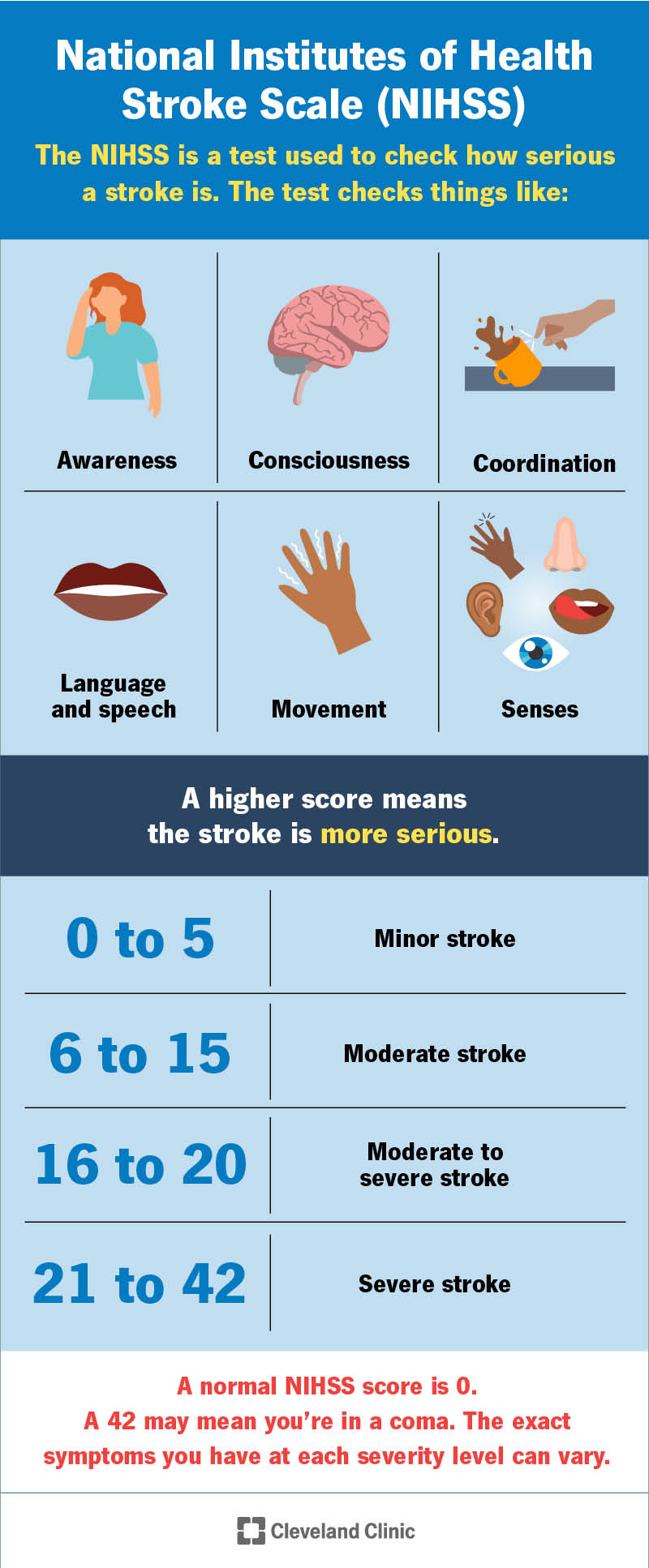The NIH Stroke Scale is a quick test that shows the severity of a stroke. It checks things like speech, awareness and movement. A higher score means you have more severe symptoms. It helps your care team track changes, guide treatment and plan your recovery.
Advertisement
Cleveland Clinic is a non-profit academic medical center. Advertising on our site helps support our mission. We do not endorse non-Cleveland Clinic products or services. Policy

The National Institutes of Health Stroke Scale (NIHSS) is a test to check how serious a stroke is. It looks at how well your brain and nerves are working. The test checks things like your:
Advertisement
Cleveland Clinic is a non-profit academic medical center. Advertising on our site helps support our mission. We do not endorse non-Cleveland Clinic products or services. Policy
This assessment has about 15 parts. Each part measures a different skill. A higher score means the stroke caused more problems. Your care team uses the results to decide the best treatment.
A healthcare provider will give you the NIH stroke assessment soon after they suspect or diagnose a stroke. This helps set a baseline for your care. A baseline shows how you’re doing at the start of treatment.
You may have the same test again later, like after you start a new treatment. This lets your care team know if your symptoms are getting better or worse.
No, you don’t need to prepare for this test. You won’t need to fill out any forms, either. Your provider will ask you questions. They may write down answers on a piece of paper. Just follow their instructions as best you can.
A healthcare provider will check how different parts of your brain and body are working. They may ask you to follow simple instructions, answer questions or repeat phrases. They may also ask you to move your eyes, lift a leg or touch your finger to your nose.
The test doesn’t hurt. If you have trouble doing part of the test, that’s OK. It’s not your fault. The test is meant to show where your brain might need support, not to judge how well you’re trying. If you’re not fully awake or able to respond, your provider will still be able to complete the test by watching your movements.
Advertisement
Each part of the exam gets a score. You don’t need a perfect score. The scoring helps your care team understand your health, just like a blood test shows what’s going on inside your body.
When the test is over, your provider will add up the score and tell you the result.
It takes less than 10 minutes. It’s usually done right away in the emergency room or soon after a stroke diagnosis.
You’ll get your results right after the assessment. Your provider adds up your score as soon as the exam is done. Then, they’ll explain what the score means and how it helps guide your treatment.
Your healthcare provider will fill out the score sheet. There’s no partial credit. To get full points for a task, you must do what is asked exactly right. Your provider won’t give hints or help with answers.
It’s normal to feel nervous before any kind of test, but don’t worry. This isn’t a test you can pass or fail.
The highest possible NIHSS score is 42. A higher number means the stroke is more serious. Here’s what the scores mean:
A “normal” NIHSS score is 0. This means everything tested fine, and you don’t have any symptoms. A 42 may mean you’re in a coma. The exact symptoms you have at each severity level can vary.
What happens next depends on how serious the stroke was and the type of stroke you had. Your care team will act fast to treat it. You may need more tests, like a CT scan or MRI of your brain.
If the stroke is moderate, you might get medicine. If it’s severe, you may need surgery. The treatment depends on what caused the stroke.
No matter the type of elevated score you get, your care team will start planning your recovery and rehab. Let your provider know if you have any questions about what your results mean.
The National Institutes of Health Stroke Scale helps your providers quickly see how a stroke affects you. This gives them the information they need to act fast and provide the best possible care.
You won’t get a grade on this test like you did in school. It simply shows what’s going on in your brain and body. It’s okay if some parts feel hard. The goal is to find out where you may need help right now.
If your score is high, your provider will use that to guide your care. Your score helps shape your recovery.
Advertisement
After a stroke, it’s essential to get treated right away. Cleveland Clinic’s stroke care specialists can help you manage recovery and improve your quality of life.

Last reviewed on 10/31/2025.
Learn more about the Health Library and our editorial process.